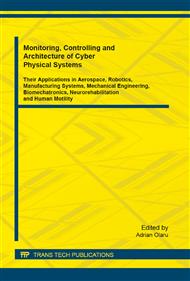[1]
R. Palm and A. Bouguerra, Navigation of mobile robots by potential field methods and market-based optimization. ECMR 2011, Oerebro, Sweden, (2011).
Google Scholar
[2]
Xiao Sun, Xiaoguang Zhao, En Li, Hongchun Li, Zize Liang, Mobile Robot Navigation Using RSSI Potential Field in Wireless Sensor Network", Journal of Computational Information Systems 6: 14 (2010) 4751-4759.
Google Scholar
[3]
R. Arunkumar, N. Balaji, Mobile robot navigation using potential field algorithm, International Journal of Advanced Engineering Applications, Vol. 4, Iss. 2, pp.26-32, (2011).
Google Scholar
[4]
Naoya Ohnishi, Atsushi Imiya, Navigation of Nonholonomic Mobile Robot Using Visual Potential Field, Proceedings of the 5th International Conference on Computer Vision Systems (ICVS 2007).
DOI: 10.1109/crv.2007.21
Google Scholar
[5]
Paolo Burelli, ArnavJhala, Dynamic Artificial Potential Fields for Autonomous Camera Control, Artificial Intelligence and Interactive Digital Entertainment, (2009).
DOI: 10.1609/aiide.v5i1.12363
Google Scholar
[6]
Luciano C. A. Pimenta, Alexandre R. Fonseca, Guilherme A. S. Pereira, Renato C. Mesquita, Elson J. Silva, Walmir M. Caminhas, and Mario F. M. Campos, Robot Navigation Based on Electrostatic Field Computation, IEEE TRANSACTIONS ON MAGNETICS, VOL. 42, NO. 4, APRIL (2006).
DOI: 10.1109/tmag.2006.870931
Google Scholar
[7]
Victor Vladareanu, Gabriela Tont, LuigeVladareanu, FlorentinSmarandache, The navigation of mobile robots in non-stationary and non-structured environments, Inderscience Publishers, Int. J. Advanced Mechatronic Systems, Vol. 5, No. 4, 2013, pg. 232- 243, ISSN online: 1756-8420, ISSN print: 1756-8412.
DOI: 10.1504/ijamechs.2013.057663
Google Scholar
[8]
Vladareanu Victor, Mingcong Deng, Schiopu Paul, Robots Extension Control using Fuzzy Smoothing, Proceedings of the 2013 International Conference on Advanced Mechatronic Systems, Luoyang, China, September 25-27, 2013, pg. 511-516, ISBN 978-0-9555293-9-9.
DOI: 10.1109/icamechs.2013.6681698
Google Scholar
[9]
Victor Vladareanu, OvidiuIlieSandru, LuigeVladareanu, Hongnian Yu, Extension Dynamical Stability Control Strategy for the Walking Robots, International Journal of Technology Management, SKIMA 2013, Inderscience Publisher, ISSN online: 1741-5276, ISSN.
Google Scholar
[10]
Francisco Bonin-Font, Alberto Ortiz and Gabriel Oliver (2010). A Visual Navigation Strategy Based on Inverse Perspective Transformation, Robot Vision, Ales Ude (Ed. ), ISBN: 978-953-307-077-3, InTech, DOI: 10. 5772/9309.
DOI: 10.5772/9309
Google Scholar
[11]
Jonathan S. Gardner, Joseph L. Austerweil, And Stephen E. Palmer, Vertical position as a cue to pictorial depth: Height in the picture plane versus distance to the horizon, Attention, Perception, & Psychophysics, 2010, 72 (2), 445-453, doi: 10. 3758/APP. 72. 2. 445.
DOI: 10.3758/app.72.2.445
Google Scholar
[12]
S. Tuohy, D. O'Cualain, E. Jones, M. Glavin, Distance Determination for an Automobile Environment using Inverse Perspective Mapping in OpenCV, IET Irish Signals and Systems Conference. IET, 2010, p.100–105.
DOI: 10.1049/cp.2010.0495
Google Scholar
[13]
Chin-TengLin, Tzu-KueiShen, Yu-Wen Shou, Construction of Fisheye Lens Inverse Perspective Mapping Model and Its Applications of Obstacle Detection, EURASIP Journal on Advances in Signal Processing, Volume 2010, doi: 10. 1155/2010/296598.
DOI: 10.1155/2010/296598
Google Scholar
[14]
AshutoshSaxena, Min Sun, Andrew Y. Ng, Make3D: Depth Perception from a Single Still Image, Proceedings of the 23rd national conference on Artificial intelligence - Volume 3, AAAI Press, 1571–1576.
Google Scholar
[15]
R. Hartley and A. Zisserman, Multiple View Geometry in Computer Vision, Cambridge University Press, p.175, (2000).
Google Scholar
[16]
Z. Sun, On-road vehicle detection, in IEEE Transactions on Pattern Analysis and Machine Intelligence, p.694–711, (2006).
Google Scholar
[17]
Gregory Dudek and Michael Jenkin, Computational principles of mobile robotics, Cambridge University Press, Cambridge, 2000, ISBN: 0-521-56021-7.
Google Scholar
[18]
Qing Li, Lijun Wang ; Bo Chen ; Zhou Zhou, An improved artificial potential field method for solving local minimum problem, Intelligent Control and Information Processing (Volume: 1 ), p.420 – 424, ), (2011).
DOI: 10.1109/icicip.2011.6008278
Google Scholar
[19]
Jian Yang, Jingrong Yu, Mi Dong, JiangminChunyu, A Strategy to Solve the Local Minima Problem for Autonomous Mechanical Vehicles, Advances in Mechanical and Electronic Engineering, LNEE 176, pp.605-610, Springer, (2012).
DOI: 10.1007/978-3-642-31507-7_96
Google Scholar
[20]
Manish Malakar, NishantSinha, A Particle Swarm Optimized Potential Field Method for Obstacle Avoidance and Path Planning of Mobile Robot, International Journal of Digital Application & Contemporary research, Volume 2, Issue 5, (2013).
Google Scholar
[21]
Steven Byrne, WasifNaeem, Stuart Ferguson, Improved APF strategies for dual-arm local motion planning, Transactions of the Institute of Measurement and Control, 2014, DOI: 10. 1177/0142331214532002.
DOI: 10.1177/0142331214532002
Google Scholar
[22]
Yan-Ping Zhang, Qing-GeJi, Ka-Ho Li, Ming-Min Zhang, Resolving Local Minima Problem of Potential Field, VRCAI '10 Proceedings of the 9th ACM SIGGRAPH Conference on Virtual-Reality Continuum and its Applications in Industry, Pages 339-346, (2010).
DOI: 10.1145/1900179.1900250
Google Scholar


